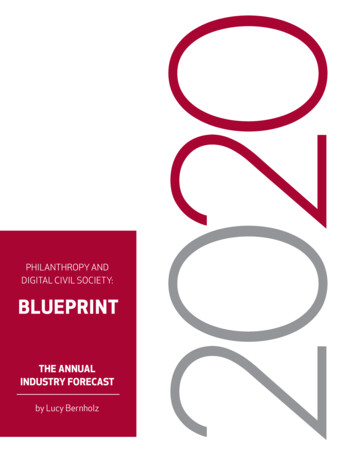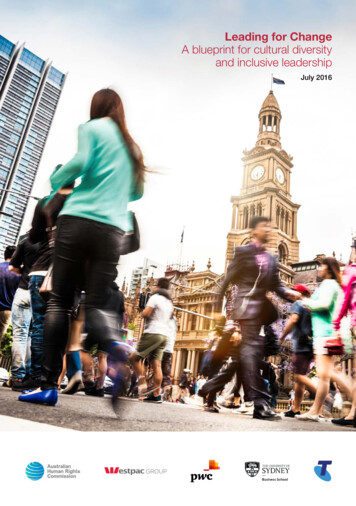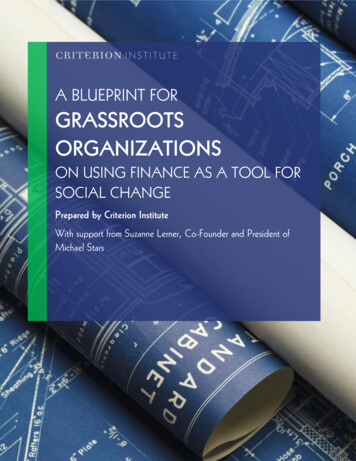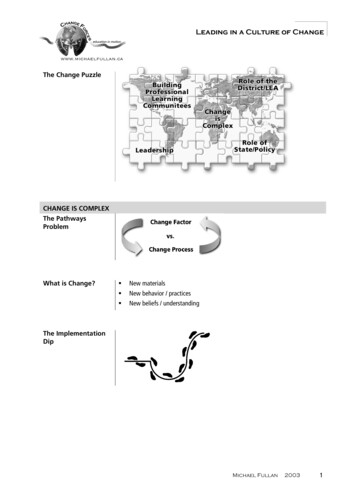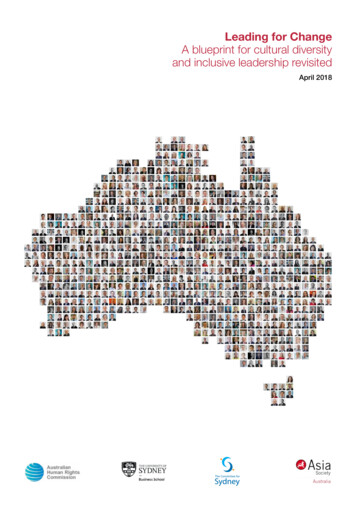
Transcription
Leading for ChangeA blueprint for cultural diversityand inclusive leadership revisitedApril 2018
Australian Human Rights Commission 2018.The Australian Human Rights Commission encourages the dissemination and exchange of information presented in this publicationand endorses the use of the Australian Governments Open Access and Licensing Framework (AusGOAL).All material presented in this publication is licensed under the Creative Commons Attribution 4.0 International Licence, with theexception of: photographs and images; the Commission’s logo, any branding or trademarks; where otherwise indicated.To view a copy of this licence, visit de.In essence, you are free to copy, communicate and adapt the publication, as long as you attribute the Australian Human RightsCommission and abide by the other licence terms.Please give attribution to: Australian Human Rights Commission 2018.Leading for Change: A blueprint for cultural diversity and inclusive leadership revisitedISBN 978-1-921449-89-5
LEADING FOR CHANGEA blueprint for cultural diversityand inclusive leadership revisited
iv
PrefaceIn 2016 the Leading for Change report highlighted the lack of cultural diversityrepresented within the senior leadership positions in Australian business, politics,government and universities. It challenged us to do better in making the most of thetalents in our multicultural nation.We have revisited the Leading for Change exercise for a number of reasons. SinceAustralia does not yet officially collect comprehensive data on cultural diversitywithin organisations and institutions, independent research is crucial to ensuring weknow the state of play. We also believe it is important to highlight what leaders andorganisations are doing to support cultural diversity and inclusion.We hope this report challenges readers to think deeply about cultural diversity.Ultimately, we hope it will be used by leaders and organisations as a blueprint foraction – because our national success and prosperity depends on us getting themost from our multicultural talents.Dr Tim SoutphommasaneRace Discrimination Commissioner,Australian Human Rights CommissionProfessor Greg WhitwellDean,The University of Sydney Business SchoolKate JordanChair, Professional and Business Services Taskforce,The Committee for SydneyPhilipp IvanovChief Executive Officer,Asia Society AustraliaApril 2018
ContentsExecutive summary01Figures1. Introduction03Figure 1: Australia’s population bycultural background072. Methodology04Figure 2: Cultural Backgrounds of Senior Leaders inAustralian Organisations08Figure 3: Cultural Backgrounds of Chief Executives09Figure 4: Cultural Backgrounds of Senior ExecutiveManagement11Figure 5: The Business Case for Cultural Diversity15Figure 6: Leadership, systems and culture162.1 C ultural backgroundand classification3. Findings04073.1 The Australian population073.2 S enior leaders of Australianorganisations073.3 Chief executives and equivalents093.4 S enior executive management(non-chief executive ‘C-suite’)114. Not just a matter of time135. Leadership, systems and culture155.1 Leadership165.2 Systems185.2.1 Data185.2.2 Accountability215.3 Culture23Table 1: Cultural Backgrounds of Senior Leaders inAustralian Organisations (Chief Executivesand Other ‘C-Suite’ Leaders)08Table 2: Cultural Backgrounds of Chief Executives09Table 3: Cultural Backgrounds of CEOsand equivalents - 201810Table 4: Cultural Backgrounds of CEOsand equivalents - 201610Table 5: Cultural Backgrounds of Senior ExecutiveManagement (non-chief executive‘C-suite’)11Table 6: Cultural Backgrounds of CEOsand equivalents125.3.1 Bias and discrimination23Case Studies5.3.2 Professional development25Case Study 1: L eadership Council onCultural Diversity19Case Study 2: Department of the Prime Ministerand Cabinet20Case Study 3: Law firms216. Challenges286.1 Ethnic zoning and visibility286.2 D ealing with deflectionsand hostility297. Tables34Case Study 4: DeloitteCase Study 5: Department of Foreign Affairsand Trade23Case Study 6: Commonwealth Bank of Australia25Case Study 7: The University of Sydney26Case Study 8: Clayton Utz27Case Study 9: Australian Broadcasting Corporation27Case Study 10: Cultural Diversity andLeadership Fellowship29Case Study 11: Special Broadcasting Service29
Executive summaryof the population have a non-Europeanbackground, and 3 per cent of the populationhave an Aboriginal or Torres Strait Islander(Indigenous) background.This study builds on the Leading for Changereport of 2016, which provided a snapshotof the cultural diversity represented in thesenior leadership of Australian organisationsand institutions.Our study examines the cultural backgrounds ofchief executive officers of ASX 200 companies,federal ministers, heads of federal and stategovernment departments, and vice-chancellorsof universities. It also examines the culturalbackgrounds of senior management at thelevel directly below chief executives andequivalent – namely, group executives of ASX200 companies, elected members of theCommonwealth Parliament, deputy heads ofgovernment departments and deputy vicechancellors of universities.We adopt a classification that includes four widegroups of cultural backgrounds, which was firstused in the Leading for Change report (2016): Indigenous background; Anglo-Celtic background; European background; andThis cultural diversity is significantly underrepresented among senior leaders in Australianorganisations and institutions.Of those who occupy 2490 of the most seniorposts in Australia, 75.9 per cent have anAnglo-Celtic background, 19.0 per cent have aEuropean background, 4.7 per cent have a nonEuropean background and 0.4 per cent have anIndigenous background.Described another way, about 95 per centof senior leaders in Australia have an AngloCeltic or European background. Althoughthose who have non-European and Indigenousbackgrounds make up an estimated 24 per centof the Australian population, such backgroundsaccount for only 5 per cent of senior leaders.Cultural diversity is particularly low within thesenior leadership of Australian governmentdepartments and Australian universities.Of the 372 chief executives and equivalentsidentified in this study, we find that 76.9 percent of chief executives have an Anglo-Celticbackground, 20.1 per cent have a Europeanbackground, and 2.7 per cent have a nonEuropean background. There is one chiefexecutive who has an Indigenous background(0.3 per cent). non-European background.Using statistical modelling based on the 2016Census, we estimate that 58 per cent of thepopulation have an Anglo-Celtic background.An estimated 18 per cent of the populationhave a European background, 21 per centCultural Backgrounds of Senior Leaders in Australian Organisations (Chief Executives andOther ‘C-Suite’ Leaders)NumberPercentage ofsenior leadersPercentage ofAustralian populationPercentage over/underrepresentation ( /-)189075.958 17.9European47419.018 1.0Non-European1164.721-16.3100.43-2.6Cultural backgroundAnglo-CelticIndigenousTotal2490Leading for Change 01
The pattern of cultural representation withinthe cohort of chief executives and equivalentsbroadly tracks that of the total group of2490 senior leaders in this study. The level ofnon-European background representation,however, is substantially lower (2.7 per centcompared to 4.7 per cent). There is a combinedtotal of 11 chief executives who have a nonEuropean or Indigenous background – or3.0 per cent of the total 372 chief executives.Put another way, 97 per cent of chief executiveshave an Anglo-Celtic or European background.This is a dismal statistic for a society that pridesitself on its multiculturalism.It challenges Australia’s egalitarian self-image.It also challenges Australia as a nation whoseprosperity relies upon international trade, capitalinflows and mobility of people.It would be complacent to believe that it willonly be a matter of time before cultural diversityis better represented. There remains limitedcultural diversity that appears in the leadershippipeline, as demonstrated by our findingsregarding non-chief executive senior leaders.Getting serious about the issue demands thatleaders and organisations take committedaction in three areas: leadership, systems andculture. We reiterate the general guidanceoutlined in Leading for Change (2016), whichcan be summarised as below.There is one general area where efforts canbe strengthened on cultural diversity. Theexperience of gender equality has demonstratedthe power of having data and reporting ongender. If we are committed to deepening oursuccess as a multicultural society, there must beconsideration of official collection and reportingof comprehensive data on cultural diversitywithin Australian organisations and institutions.Cultural Backgrounds of Chief Executives and equivalentsNumberPercentage ofsenior leadersPercentage ofAustralian populationPercentage over/underrepresentation ( /-)28676.958 18.9European7520.118 2.1Non-European102.721-18.310.33-2.7Cultural 1. Provide leadership on cultural diversity that is authentic and humble2. Equip and support leaders from diverse backgrounds to be role models3. Leaders must be prepared to respond to deflections and backlashSystems1. Collect meaningful data on cultural diversity2. Accompany any data initiative with deeper conversations about cultural differences3. Where there is data, consider targets and accountability for cultural diversity and inclusionacross the organisationCulture1. Mitigate bias and discrimination by promoting positive contact between different culturalbackgrounds2. Unlock the potential of multicultural talent through targeted professional development3. Go beyond cultural celebration and cultivate organisational resilience in negotiatingcultural differences02
1. IntroductionAustralia is widely celebrated as a multiculturaltriumph, but any such success remainsincomplete. There remains significant underrepresentation of cultural diversity in the seniorleadership of Australian organisations. Oursociety does not yet appear to be making themost of its diverse talents.Doing so is important, not only as a naturalprogression of our multiculturalism, but alsobecause it is necessary. Australia needs adiversity of ideas, capabilities and culturalintelligence to navigate technological, social,economic and geopolitical changes.In 2016, for the first time, research provided astatistical snapshot of the cultural diversity ofsenior leaders in business, politics, governmentand higher education. As published in Leadingfor Change: A Blueprint for Cultural Diversity andInclusive Leadership, the story was an unhappyone. There was an almost total absence of nonEuropean backgrounds represented among thecohort of chief executives in Australia.During the past two years, more attention hasbeen devoted to getting cultural diversity right.There is growing recognition that efforts ondiversity and inclusion have focused primarilyon gender, and have downplayed or ignoredculture and race. This is a welcome, thoughoverdue, development.At the same time, concerns about culturaldiversity are still often assimilated intodiscussions about gender diversity. Forexample, while there are some similarities inthe obstacles for greater gender and culturaldiversity in leadership, the issues are by nomeans identical. There is a need to givededicated time and energy to cultural diversityin its own right.This report provides an updated overview of therepresentation of cultural diversity in the seniorleadership of Australian organisations. Applyingand updating the methodology used in Leadingfor Change (2016), it gives a breakdown of thecultural diversity of the two most senior tiers ofsenior management within the ASX 200 groupof listed companies, Commonwealth and Stategovernment departments and universities. Thereport also provides statistics for the culturaldiversity of the Australian Parliament.The findings of this report suggest we have along way to go before realising the full potentialof our multicultural population. If progress isbeing made on cultural diversity, it remains slow.We reiterate that improving the representation ofcultural diversity requires action at three levels:leadership, systems and culture. Through aseries of case studies drawn from Australianorganisations’ experience, we highlightexamples of how such concrete steps canbe taken.This report does not purport to provide anexhaustive treatment of cultural diversityand leadership. It aims, though, to provide areference point for understanding how we arefaring. This includes providing a classificationthat can assist in discussing cultural diversity.This report also aims to provide some thematicguidance to organisations, in light of currentdebates. In addition to the inherent challenge ofdealing with race and culture, a contemporarybacklash against diversity might also impedeprogress. In the United States, Britain andEurope, political debates have exhibited ahardening of sentiments against immigration andmulticulturalism. This has been accompanied bynotable campaigns against diversity initiativeswithin workplaces, including within Silicon Valley.There are signs that such sentiments may alsobe gaining strength here in Australia.None of this gives us a reason to abandoncultural diversity. The fact that something is hardto do does not in any way mean that it is not theright thing to do. But it does mean advocatesfor cultural diversity must be prepared to updatetheir thinking and reinvigorate their language.Leading for Change 03
2. MethodologyOur study examined the cultural backgrounds ofchief executive officers of ASX 200 companies,federal government ministers, heads of federaland state government departments, and vicechancellors of universities. It also examined thecultural backgrounds of senior managementat the level directly below chief executivesand equivalent – namely, group executives ofASX 200 companies, elected members of theCommonwealth Parliament, deputy heads ofgovernment departments and deputy vicechancellors of universities.1These cohorts were chosen to illustrate therepresentation of cultural diversity amongleaders in business, politics, government (publicservice) and civil society.2.1 Cultural backgroundand classificationWe consider cultural background to referprimarily to a person’s ethnicity and ancestry.The concept of ethnicity can be understoodto relate to a human group or population thathas a common origin, and which may exhibitshared defining features such as homeland,language, customs, historical tradition, religionand physical appearance.2 We regard ancestry –a person’s descent and family background – asinextricably tied to ethnicity.Our study adopts a classification that includes fourwide groups of cultural backgrounds, which wasfirst used in the Leading for Change report (2016):1. Indigenous background;2. Anglo-Celtic background;3. European background; and4. non-European background.04The use of this classification, and the way inwhich cultural backgrounds are grouped, doesnot imply the expression of an opinion on thepart of the authors about the recognition ofsuch backgrounds by governments or thestatus accorded to them. It does not implythat there are only four ways in which people’scultural backgrounds can be expressed orcaptured – using this classification does nothingto prevent or deny people from expressingtheir cultural background or heritage. We usethis classification simply as a conceptual aidto understanding the representation of culturaldiversity. It provides a means of aggregatingcultural backgrounds in a way that permits moresophisticated analysis than otherwise possible.The meaning of the classification can beexplained in the following way.‘Indigenous’ designates those who have anAboriginal or Torres Strait Islander culturalbackground.‘Anglo-Celtic’ describes those culturalbackgrounds that are English, Scottish, Welshand Irish.3 ‘European’ includes all Europeanbackgrounds other than Anglo-Celtic – includingNorth-West European (e.g. German, French,Dutch) and Southern and Eastern European(e.g. Italian, Greek, Polish).‘Non-European’ encompasses all other culturalbackgrounds, including South-East Asian(e.g. Vietnamese, Malaysian), North-East Asian(e.g. Chinese, Japanese, Korean), Southern andCentral Asian (e.g. Indian, Sri-Lankan, Afghani),Latin American (e.g. Mexican, Colombian),Middle Eastern and North African (e.g. Egyptian,Turkish), Sub-Saharan African (e.g. Nigerian,Zimbabwean) and Oceanic and Pacific Islander(e.g. Maori, Tongan).4
The use of any such categories necessarilyreflects the history of a particular society andthe preponderance of groups within it. Webelieve the above four categories – Indigenous,Anglo-Celtic, European, non-European – areappropriate in light of Australia’s demographichistory. In particular, they reflect the main wavesof immigration that have primarily shaped thecomposition of Australian society today.For some 60 000 years Australia was solelyoccupied by Aboriginal and Torres StraitIslander peoples, until the arrival of the FirstFleet in 1788. With the colonisation of Australia,the population would become predominantlyBritish (English, Scottish, Welsh) and Irishin background. Scholars refer to Australiannational identity being shaped during its colonialera by an ‘Anglo-Celtic’ hybrid culture.5Such composition in the Australian colonialpopulation was reinforced by cumulativeimmigration from the British Isles. Significantnumbers of Chinese and other immigrantsarrived during the gold rushes in the second halfof the 19th century; there would also be manythousands of Pacific Islander workers who cameto Australia as indentured labourers in the 19thcentury, largely in Queensland. But immigrationrestrictions imposed by colonial and later theCommonwealth governments meant the culturalimpact of such immigration – namely, of nonAnglo-Celtic origin – was limited.The maintenance of the White Australia policyfor most of the 20th century meant thatimmigration was mainly from the British Isles –that is, until the post-Second World War period.The 1950s and 60s were years when significantnumbers of immigrants from Europe settled inAustralia. This would inject a new (non-AngloCeltic) European cultural component to theAustralian population.The next waves of immigration have been of anon-European origin, with the formal dismantlingof the White Australia policy in 1973, and thearrival of refugees following the conclusion ofthe Vietnam War and related strife in Cambodiaand Laos.The late 1970s and early 1980s saw some70 000 Indochinese refugees resettled inAustralia, with many more thousands of theserefugees’ relatives arriving in later years throughfamily reunion programs. This has also beenaccompanied by the arrival of immigrants fromother countries in Asia, as well as the MiddleEast, South America and Africa.62.2 Our process of classificationIn determining the cultural backgroundof Australian leaders in business, politics,government, and higher education, weexamined the following:a. publicly available biographical informationabout the individual (e.g. organisation websiteand Who’s Who entry);b. other relevant public statements that mayinclude information about the individual’scultural background (e.g. speeches andmedia reports);a. an individual’s full name and its origins;b. an individual’s place of birth; andc. photographs of the individual.Where possible, we have sought to findreferences to ancestry and cultural backgroundgoing back as far back as two generations (thatis, to a person’s grandparents). After gatheringthe available data, we then placed leaders’cultural backgrounds into one of the fourcategories: Indigenous, Anglo-Celtic, European,non-European.Such a methodology is consistent withacademic and industry studies of culturalbackground, as well as some internationalmonitoring practices.7 For example, in itsCapitalising on Culture study of corporateAustralia, Diversity Council Australia measuredcultural diversity based on the surnames ofboard and senior executive managers in ASX200 companies.8Leading for Change 05
Academic research in the United Statesby sociologists investigating the culturalbackgrounds of CEOs in Fortune 500companies has drawn upon biographicalinformation about race and ethnicity, as wellas photographs.9 Similarly, managementresearchers from Ryerson University, in theirannual studies measuring diversity amongleaders in Canada, have relied upon publicinformation such as captioned photos andbiographies to identify leaders and theirdemographic profiles.10 The United States EqualEmployment Opportunity Commission, in itsinstructions for its EEO-1 survey form (which allcompanies employing more than 100 peopleare required to submit), indicates that where‘employee declines to self-identity, employmentrecords or observer identification may beused’.11 A 2017 study of race and leadership inthe United Kingdom, involving a sample of morethan 1000 senior leaders, used a combination oflists and photographs to identify the backgroundof leaders.12After an initial review and identification of anindividual’s cultural background, the authorsreviewed the assessments made. We have erredon counting more cultural diversity than lesswithin leadership cohorts. Where we have beenunsure of how to classify someone’s culturalbackground for the purpose of this study, wehave favoured counting someone as Europeanrather than Anglo-Celtic, as non-Europeanrather than European, and as non-Europeanrather than Anglo-Celtic.06For example, in classifying an individualhas a father of Scottish background buta mother of Italian background, we wouldcount that individual as having a Europeanbackground rather than Anglo-Celtic. Withinthis exercise, an individual who has a father ofChinese background but a mother of Germanbackground, would be counted as havinga non-European background rather thanEuropean. Similarly, in the case of an individualwho has a father of English background buta mother of Indian background, we wouldcount that individual as having a non-Europeanbackground rather than Anglo-Celtic.
3. Findings3.1 The Australian populationProviding definitive statistics about the culturaldiversity of the Australian population is a difficulttask. There are no official statistics on the ethnicor cultural composition of the population. TheAustralian Bureau of Statistics, through theCensus, collects data on people’s place ofbirth, languages spoken at home, and selfidentified ancestry. However, none of thesevariables alone provide a satisfactory measure ofcultural diversity.In 2016, the Leading for Change report referredto studies suggesting at least 10 per cent of thepopulation have a non-European background.It drew upon Census figures from 2011 whichshowed that almost half of the Australianpopulation were born overseas, or have a parentborn overseas.13New analysis, undertaken for this report,provides an updated estimate of Australia’scultural diversity. By combining aggregate datafrom the 2016 Census and record-level datafrom the 2011 Census, in particular responsesto questions about ancestry and Aboriginal andTorres Strait Islander identification, we suggestthat the Australian population is even moreculturally diverse than previously estimated.14We estimate that about 58 per cent of thepopulation has an Anglo-Celtic background.An estimated 18 per cent of the population hasa European background, 21 per cent of thepopulation has a non-European background,and 3 per cent of the population has anAboriginal or Torres Strait Islander (Indigenous)background. According to these estimates,Australia’s cultural diversity has increasedover time.Figure 1: Australia’s population by opeanIndigenous18Sources: ABS; estimates from RBA ERG3.2 Senior leaders of AustralianorganisationsThe cultural diversity of Australian society issignificantly under-represented within the seniorleadership of Australian organisations. Our studyexamined senior leaders in business, politics,government and higher education. Of thosewho occupy 2490 of the most senior posts inAustralia, 75.9 per cent have an Anglo-Celticbackground, 19.0 per cent have a Europeanbackground, 4.7 per cent have a non-Europeanbackground and 0.4 per cent have anIndigenous background.Described another way, about 95 per centof senior leaders in Australia have an AngloCeltic or European background. Althoughthose who have non-European and Indigenousbackgrounds make up an estimated 24 per centof the Australian population, such backgroundsaccount for only 5 per cent of senior leaders.Leading for Change 07
This finding of under-represented culturaldiversity is consistent with patterns in manyother countries described as multicultural ormultiethnic. According to McKinsey’s Deliveringthrough Diversity report (2018), in the UnitedStates, black Americans comprise 10 percent of graduates but only 4 per cent of seniorexecutives, Hispanics and Latinos comprise8 per cent of graduates but only 4 per cent ofsenior executives, and Asian Americans makeup 7 per cent of graduates versus 5 per cent ofexecutives. In the United Kingdom, 22 percentof university students identify as Black andMinority Ethnic, yet make up only 8 percent ofBritish senior executives.15 Such disparity wasalso found in the The Colour of Power study(2017), which showed that for more than 1000of the most senior posts in the UK in business,politics, government, sport, media and the arts,only 3.4 per cent of occupants are Black andMinority Ethnic (BME) – compared to 12.9 of thegeneral British population.16Table 1: Cultural Backgrounds of Senior Leaders in Australian Organisations (Chief Executivesand Other ‘C-Suite’ Leaders)Percentage ofsenior leadersPercentagePercentage over/of Australian under-representationpopulation( /-)Cultural 9.018 Eastern andNorthern African220.9Other 0Figure 2: Cultural Backgrounds of Senior Leaders in Australian OrganisationsPercentage of senior ndigenous19.008 17.9
3.3 Chief executives and equivalentsequivalents broadly tracks that of the total groupof 2490 senior leaders in this study, the levelof non-European background representation issubstantially lower (2.7 per cent compared to4.7 per cent). There is a combined total of 11chief executives who have a non-European orIndigenous background – or 3.0 per cent of thetotal of 372 chief executives. Put another way,97 per cent of chief executives have an AngloCeltic or European background. This is a dismalstatistic for a society that prides itself on itsmulticulturalism and egalitarianism.Of the 372 chief executives and equivalentsidentified in this study, we find that 76.9 percent of chief executives have an Anglo-Celticbackground, 20.1 per cent have a Europeanbackground, and 2.7 per cent have a nonEuropean background. There is one chiefexecutive who has an Indigenous background(0.3 per cent).While the pattern of cultural representationwithin the cohort of chief executives andTable 2: Cultural Backgrounds of Chief ExecutivesCultural backgroundNumberAnglo-CelticPercentage ofsenior leadersPercentagePercentage over/of Australian under-representationpopulation( /-)28676.958 18.9European7520.118 stern andNorthern African20.55Other igure 3: Cultural Backgrounds of Chief ExecutivesPercentage of chief anIndigenous20.1Leading for Change 09
We find that, of the ASX 200 group of chiefexecutives (n 200), 72.5 per cent have anAnglo-Celtic background, 23.5 per cent havea European background, and 4 per cent havea non-European background. There is no oneamong the ASX 200 chief executive cohort whohas an Indigenous background. Compared to2016, there has been a small increase in thelevel of European backgrounds, accompaniedby an almost equivalent decrease in therepresentation of Anglo-Celtic backgrounds.The level of non-European representation hasfallen from 5 per cent to 4 per cent.Within the federal government ministry(n 30) 83.4 per cent have an Anglo-Celticbackground, 13.3 per cent have a Europeanbackground, and 0 per cent have a nonEuropean background. 3.3 per cent have anIndigenous background, meaning one memberof the ministry. This reflects a higher level of nonAnglo-Celtic background representation from2016, in particular, of European backgrounds.Among federal and state governmentdepartmental secretaries or chief executives(n 103), 84.5 per cent have an Anglo-Celticbackground, 14.5 per cent have a Europeanbackground, and 1 per cent have a nonEuropean background. There is no one amongthe department secretary/chief executive groupthat has an Indigenous background. Comparedwith 2016, this reflects a slight increase in theproportion of Anglo-Celtic representation, and aslight decrease in European, non-European andIndigenous representation.Within the cohort of university vice-chancellors(n 39), 74.3 per cent have an Anglo-Celticbackground, 23.1 per cent have a Europeanbackground, and 2.6 per cent have a nonEuropean background. None of Australia’s 39university vice-chancellors has an Indigenousbackground. While these statistics reflect a risein the level of non-Anglo-Celtic representationwhen compared to 2016, the small size ofthis cohort means the result may not be asdramatic as it may appear. The rise in nonEuropean backgrounds, for instance, reflectsthe entry of one vice-chancellor who has a nonEuropean background.Table 3: Cultural Backgrounds of CEOs
As published in Leading for Change: A Blueprint for Cultural Diversity and Inclusive Leadership, the story was an unhappy one. There was an almost total absence of non-European backgrounds represented am







